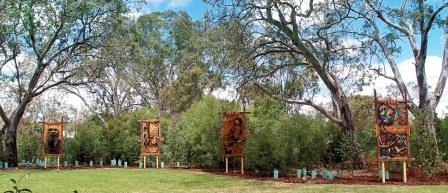Cultural History

Aboriginal History of the area
The home country of the Peramangk people is believed to have been in the Eastern Mount Lofty Ranges from Myponga, north to Gawler and Angaston, East to Wright Hill, Strathalbyn, Kanmantoo, and along the eastern scarp of the range to near Towitta. The Peramangk lived much of the year in the vicinity of Mount Baker and on a strip of Red Gum country, running north to the Angaston district. In the winter they kept to the plains areas below 365m, since the wet sclerophyll forests at higher elevations were wet and cold. In the 1830s when the first Europeans arrived in the district about 300 Aboriginal people were camped along Laratinga (Mount Barker Creek), and approximately 300 were also sited at the Mount Barker Springs (Schmidt, 1983).
With the advancement of agricultural development, which displaced many Aboriginals and the spread of infectious diseases introduced by the Europeans the population of Aboriginal people declined dramatically. Very little documentation of the Peramangk people exists beyond the 1850s and it is thought those who remained integrated with the Ngarindjeri of the lower Murray and the Kaurna of the Adelaide plains (Draper, 1985 in Crawford, 1997).
The nearby Mount Barker Summit is a significant site of Aboriginal heritage and believed to be one of the most sacred Aboriginal sites near Adelaide. In 1987 the Ngarindjeri people protested against the building of the Telecom tower, this however was unsuccessful. In 1984 they had tried to prevent a police radio tower being built at the site, this too was unsuccessful (Crawford, 1997).

Post European History
What is today known as Mount Barker was first sighted by Captain Sturt from Lake Alexandrina in February 1830, though Sturt believed he was looking at Mount Lofty, which Flinders had discovered in 1802. Captain Collett Barker rectified this error when he undertook a survey of the district in 1831. Sturt renamed the mountain in honour of Captain Barker who was killed by Aborigines while exploring near the mouth of the River Murray later that year.
Captain Sturt favourably reported on the agricultural potential of the area, with rich soils and luxuriant native pastures of the surrounding undulating hills and plains, but it was not until the late 1830s that this area was explored further. The first Special Survey of the Mount Barker District was opened to prospective buyers in march, 1840 (Schmid, 1983 in Crawford, 1997). Land was cleared and the rich agricultural land was developed for grazing and crop production. In February 1840 the proposed layout of the township of Mount Barker was announced.
The first settlers to arrive in Mount Barker were mainly engaged in dairying and pastoralism. Sheep grazing became popular, as did the growing of wheat. As the wheat industry expanded, several mills were constructed in the district. Mount Barker expanded rapidly with the settlement of mill workers and the commencement of the usual businesses of a township to supply their needs.
Subterranean clover was discovered in the District in 1889 by Amos Howard, a farmer and nurseryman (Schmidt, 1983). Sub clover improved the soil, and large areas of depleted farmland were turned into productive pastures. The Mount Barker district became known as the 'cream bowl' as the discovery of clover resulted in the dairy industry flourishing.
Today the agricultural industry in Mount Barker is primarily cropping and grazing country. Mount Barker is located just off the South Eastern Freeway, and with the recent construction of the Heysen Tunnels and associated development it is much quicker to travel from the city to the township. Mount Barker is now characterised by a rapidly growing population, with an associated rapid rate of development. The retail and industrial sectors have been experiencing expansion as the population grows.
History of the Site of the Laratinga Wetland
The site was formerly used for growing improved pastures and the grazing of cattle. Cattle were relocated in early 2000 to make way for the new wetland development. The site was heavily infested with pasture plants and weeds with a general lack of native plants within the site. As Community Wastewater Management System (CWMS) treatment plant was constructed immediately west of the wetland site and was upgraded in 1997. The water produced from the treatment processes had been previously discharged into the Mt Barker Creek, which runs along the southern edge of the wetland basins. The addition of treated effluent water increased the flow of the naturally ephemeral creek (naturally dried to pools in summer and flowed in winter-spring). Blooms on non toxic algae in the creek also indicated that the addition of the effluent treated water increased the nutrient load of the creek.
More Information
Want to know more about the Laratinga Wetlands? Click on the links below.
> About Laratinga Wetlands
> Wetland Systems
> Ecological Features
> Fauna
> Flora
> Cultural History
> Programs - Environmental and Volunteer
> Visitor Sustainability
> Walking Trails
> News/Events
> Home

